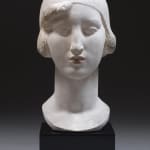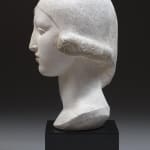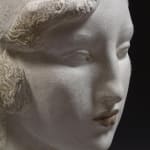


Alfred Janniot French, 1889-1969
Length: 7.5 in.
Depth: 6.3 in.
Further images
In 1919, Janniot had been studying for several years at the Ecole de Beaux Arts, Paris in the atelier of the sculptor, Injalbert. The same year he received the Grand Prix de Rome—a grant to study for four years at the Académie des Beaux Arts of Rome, housed in the famous Villa Médicis.
In the end of his first academic year, 1921, Janniot created a carved pink marble sculpture titled “Tête idéale“. According to academics, it qualifies as “neo-archaic,” the sculpture, immediately evoking ancient Greece. The intricately sculpted hair also references Roman busts that were depicted with thick curls, as well as a Roman nose and almond shaped eyes. Further, the use of color on the lips of the face is a reference to the timeworn color found on the bas-reliefs of the Pantheon. Her elongated neck and the face were inspired by Quattro-cento’s classicism and Fontainebleau mannerism.
Janniot made several preparatory plaster drafts for the marble version, ours seemingly being the very first one. The sculpture remained in the artist’s studio until it was purchased by the previous owner near the end of his lifetime.
Provenance
Private collection, acquired directly from the artist in the 1960’s
Exhibitions
Pink marble version of the same model:
Envois de Rome à la Villa Médicis exhibition and in Beaux Arts de Paris courtyard, September 1921.
Salon des Artistes Français, 1923.
Salon des Artistes Décorateur, 1924.
Publications
Plaster version: Les Echos d’Art n°42, January 1929, p 1, presented in a J.E. Ruhlmann designed interior.


